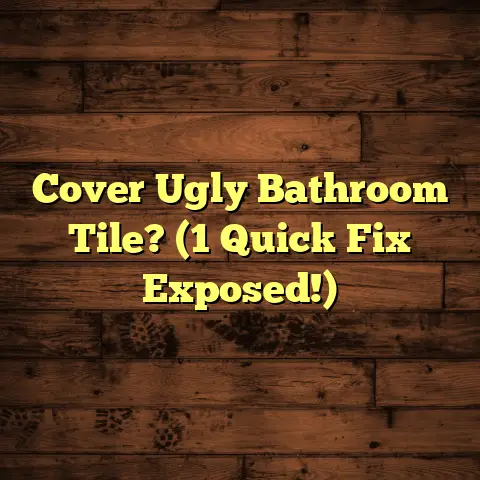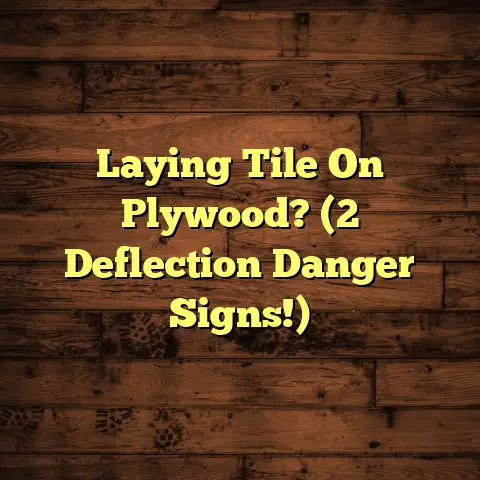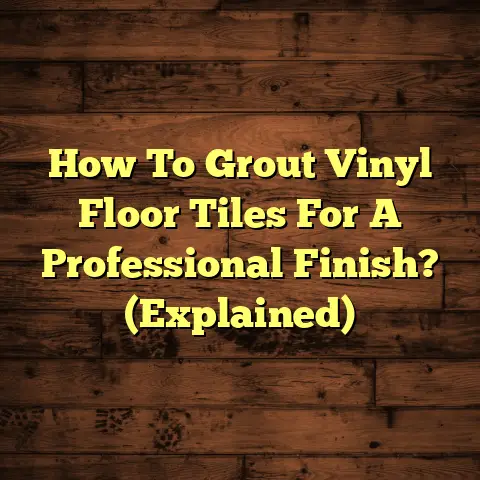Repair Laminate: No Replacement Needed? (Quick Fix!)
Imagine this: It’s Thanksgiving. The whole family’s here, laughter bouncing off the walls, kids are running amok, and the aroma of turkey fills the air.
Our living room, with its laminate floor, is the heart of it all. It’s seen it all – toy car races, the occasional spilled cranberry sauce, and even a rogue tap-dancing incident (thanks, Uncle Jerry!).
But lately, I’ve noticed the floor isn’t looking its best. Scratches, a water stain from that overly enthusiastic fern, and a small dent from when my son decided his scooter belonged indoors.
The thought of replacing the entire floor? A nightmare! It feels wasteful, expensive, and honestly, who has the time?
That’s why I’m here to tell you that often, you don’t need to replace your laminate floor. Quick fixes can work wonders! Let’s dive into how.
Understanding Laminate Flooring
So, what is laminate flooring, exactly? Think of it as a layered sandwich. It’s typically made of four main components:
-
Wear Layer: This is the top, transparent layer that protects against scratches, stains, and fading.
-
Decorative Layer: This layer gives the floor its look. It’s a printed image that mimics wood, stone, or tile.
-
Core Layer: Usually made of high-density fiberboard (HDF) or medium-density fiberboard (MDF), this is the core that provides stability and impact resistance.
-
Backing Layer: The bottom layer that provides a moisture barrier and helps prevent warping.
Laminate’s popularity stems from its affordability, ease of installation (hello, DIY!), and the fact that it can mimic the look of more expensive materials like hardwood. I mean, who doesn’t love a good deal?
But like anything, laminate has its weaknesses. Over time, I’ve seen it all:
-
Scratches: From pets, furniture, or just plain wear and tear.
-
Chips: Usually from dropped objects or heavy impact.
-
Warping: Often caused by moisture exposure.
-
Fading: Prolonged exposure to sunlight can cause the decorative layer to fade.
These issues can make your floor look tired and worn, but don’t despair! Most of the time, they can be fixed without resorting to a full replacement.
Assessing the Damage
Before you grab your toolbox, it’s crucial to assess the damage. Think of yourself as a flooring detective!
1. Surface Scratches:
These are the most common. They’re usually superficial and don’t penetrate the wear layer.
- How to Identify: Look for light, hairline scratches that are only visible from certain angles.
2. Deeper Gouges:
These penetrate the wear layer and can expose the decorative layer or even the core.
- How to Identify: These are more noticeable and have more depth. You can usually feel them when you run your finger over the surface.
3. Water Damage:
This can cause swelling, warping, or discoloration.
- How to Identify: Look for raised areas, bubbling, or dark stains. Check around areas prone to spills, like near sinks or doorways.
4. Warping:
This is when the planks start to lift or buckle.
- How to Identify: Visually inspect the floor for areas that are no longer flat. You might also notice gaps between planks.
Once you’ve identified the type and extent of the damage, you can categorize it:
-
Minor: Surface scratches, small chips, or minor water stains.
-
Moderate: Deeper gouges, larger chips, or localized warping.
-
Severe: Extensive water damage, widespread warping, or significant damage to multiple planks.
Minor to moderate damage is usually fixable with DIY methods. Severe damage might require professional help or plank replacement.
Quick Fix Techniques
Alright, let’s get to the good stuff! Here are some of my go-to quick fix techniques for repairing laminate flooring:
For Scratches:
1. Laminate Repair Kits:
These kits are like magic wands for scratches. They usually include a variety of colored fillers and a heating tool to melt and blend the filler into the scratch.
-
How to Use:
- Clean the area around the scratch.
- Choose a filler color that closely matches your floor.
- Heat the filler with the tool and apply it to the scratch.
- Use the tool to blend the filler into the surrounding surface.
- Let it dry completely and buff smooth.
2. Laminate Markers or Crayons:
These are a simpler option for surface scratches. They’re like colored markers that you use to fill in the scratch.
-
How to Use:
- Clean the area around the scratch.
- Choose a marker or crayon color that closely matches your floor.
- Color in the scratch with the marker or crayon.
- Wipe away any excess with a clean cloth.
3. DIY Walnut or Coconut Oil:
This is my secret weapon for minor scratches. The natural oils can help to buff out the scratch and restore the shine.
-
How to Use:
- Apply a small amount of walnut or coconut oil to a clean cloth.
- Gently rub the cloth over the scratch in a circular motion.
- Buff the area with a clean, dry cloth.
For Dents:
1. The Steam Method:
This method uses steam to raise the dent back to its original shape.
-
Tools Needed:
- Iron
- Damp cloth
- Towel
-
How to Use:
- Place the damp cloth over the dent.
- Place the towel over the damp cloth.
- Set the iron to a low setting and gently iron over the towel for a few minutes.
- Remove the iron, towel, and cloth and let the area dry completely.
- Repeat if necessary.
2. Damp Cloth and Iron (Alternative):
If you don’t have a steamer, this method can also work.
-
How to Use:
- Soak a clean cloth in water and wring it out so it’s damp but not dripping.
- Place the damp cloth over the dent.
- Set the iron to a low setting (no steam!) and gently iron over the cloth for 10-20 seconds.
- Remove the iron and cloth, and let the area air dry.
- Check if the dent has lifted. Repeat the process several times if needed, allowing the area to cool down between each application.
For Chips:
1. Wood Filler or Putty:
This is the go-to solution for filling in chips and gouges.
-
How to Use:
- Clean the area around the chip.
- Apply a small amount of wood filler or putty to the chip.
- Use a putty knife to smooth the filler and blend it into the surrounding surface.
- Let it dry completely.
- Sand the area smooth with fine-grit sandpaper.
- If necessary, apply a laminate repair marker or paint to match the color of your floor.
For Water Damage:
1. Drying Techniques:
For minor water damage, the key is to dry the area as quickly as possible.
-
How to Use:
- Wipe up any standing water immediately.
- Use fans to circulate air and dry the area.
- If the damage is localized, you can use a hairdryer on a low setting to speed up the drying process.
2. Repair Kits:
For minor water stains, laminate repair kits can sometimes help.
-
How to Use:
- Follow the instructions on the repair kit to clean and treat the affected area.
3. Plank Replacement:
For more severe water damage, you might need to replace the affected plank. Don’t panic! You don’t necessarily have to replace the entire floor.
-
How to Use:
- Carefully remove the damaged plank using a chisel or pry bar.
- Clean the area where the new plank will be installed.
- Install the new plank, making sure it clicks into place properly.
- You may need to use a tapping block and hammer to ensure a tight fit.
Preventive Measures to Maintain Laminate Flooring
Prevention is always better than cure, right? Here are some tips to keep your laminate floor looking its best:
-
Regular Cleaning: Sweep or vacuum regularly to remove dirt and debris.
-
Appropriate Cleaning Agents: Use a laminate-specific cleaner or a mixture of water and vinegar. Avoid harsh chemicals or abrasive cleaners.
-
Mats at Entryways: Place mats at entryways to trap dirt and moisture.
-
Furniture Pads: Use furniture pads under furniture legs to prevent scratches and dents.
-
Avoid Excessive Moisture: Clean up spills immediately and avoid using excessive water when cleaning.
When to Seek Professional Help
Okay, let’s be real. Sometimes, DIY just isn’t enough. Here are some situations where you should call in the pros:
-
Extensive Water Damage: If you have widespread water damage or suspect mold growth, it’s best to call a professional.
-
Widespread Warping: If multiple planks are warped or buckled, it could indicate a larger issue with moisture or subfloor problems.
-
Difficult Repairs: If you’re uncomfortable with any of the DIY techniques or if the damage is too complex, don’t hesitate to seek professional help.
The cost of professional laminate flooring repairs can vary depending on the extent of the damage and the labor rates in your area. Expect to pay anywhere from \$100 to \$500 for minor repairs, and upwards of \$1,000 for more extensive damage.
Success Stories
I’ve seen some amazing laminate floor transformations over the years. Here’s one that sticks out:
My friend Sarah had a laminate floor in her kitchen that was covered in scratches from her two rambunctious dogs. She was ready to rip it all out and replace it.
I convinced her to try a laminate repair kit first. She was skeptical, but she followed the instructions carefully, and the results were amazing! The scratches were almost invisible, and her floor looked brand new. She saved herself thousands of dollars and a whole lot of hassle.
I’ve also had clients who successfully used the steam method to remove dents from dropped furniture, and others who replaced individual planks damaged by water leaks. The key is to be patient, follow the instructions carefully, and don’t be afraid to experiment.
Conclusion: Embracing the Charm of Imperfection
Let’s face it: life happens. Floors get scratched, things get spilled, and sometimes, furniture takes a tumble. But these imperfections don’t detract from the beauty of your home. In fact, they add character and tell a story.
Your home is a sanctuary filled with love, memories, and yes, the occasional imperfection. By embracing DIY repairs, you can maintain your home’s integrity and warmth without breaking the bank.
So, the next time you spot a scratch or a dent on your laminate floor, don’t panic! Grab your toolbox, try one of these quick fix techniques, and remember that with the right knowledge and tools, you can easily repair your laminate flooring without the need for replacement.
And hey, maybe that little imperfection will become a conversation starter, a reminder of a funny story, or just a quirky detail that makes your home uniquely yours.





